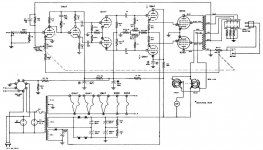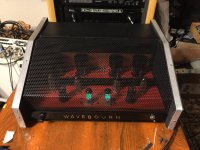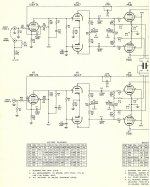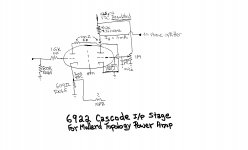Hello, from a newbie. I would like to build a tube amp to drive my Magneplanar 1.6/R. I do have two unrestored Dynakit Mark 3’s, but don’t know if they will have enough reserve power. I have rebuilt a ST70 and run it in pentode and triode mode. I love the triode mode but at an estimated 12Watts I can only listen at very low levels before the fuse on the Magneplanar blows. I have returned to a solid state amp and hate it (I don’t have the money for a high end solid state amp). I would like to build an Ultra linear amp with 4 x KT88”s and a Hammond 1650TA OPT, but am having a problem finding information on parallel tube configurations for the KT88’s. I would appreciate any opinions on what amp configuration would be best for the Magneplanar or am I under estimating the Mark 3’s?
Are you talking about the 1.6 QR? I had a pair that I ran with a heavily modified Citation II with about 70W per channel. I didn't care that much for the MKIII driving them, but YMMV.
Later I ran them with a pair of PP 300B monoblocks (30W) which also worked pretty well.
They're a fairly easy load for most tube amps, but they are not that efficient and 50 - 150W per channel is reasonable.
(My old ST-70 design in triode was 17W per channel, I'm assuming that if you are blowing the tweeter fuse you are clipping the amp pretty badly, I never blew the fuses in MQ1.4 or the later MQ1.6 QR)
Later I ran them with a pair of PP 300B monoblocks (30W) which also worked pretty well.
They're a fairly easy load for most tube amps, but they are not that efficient and 50 - 150W per channel is reasonable.
(My old ST-70 design in triode was 17W per channel, I'm assuming that if you are blowing the tweeter fuse you are clipping the amp pretty badly, I never blew the fuses in MQ1.4 or the later MQ1.6 QR)
Thank you both for the quick reply. Yes it is a 1.6 QR. kevinkr, a 300B mono block would be cool, as they make a visual statement. Eli, I will look into the Heath W6M. Any recommended alternative to the Hammond?
Eli, I will look into the Heath W6M. Any recommended alternative to the Hammond?
Low frequency instability is the "Achilles Heel" of Williamson style circuitry. First class O/P "iron" is appropriate, to hold phase shifts down. Heyboer may be able to "duplicate" the stuff Heath used. O'netics, ElectraPrint, and MagneQuest are other winders that may help. It will not be inexpensive, like Hammond. However, you have nice speakers that deserve GOOD amplification.
Remember, I said point of departure. The topology is fundamentally sound, but gain structure can and, IMO, should be altered to be compatible with modern digital sources. Also, 100% high transconductance (gm) small signal types should be selected for their resistance to slew limiting induced by the HF error correction signal out of the NFB loop. FWIW, I'd eliminate the damping factor adjustment and make the panels obey orders.
300B SE is not enough. GU-50 PP or at least KT-88 are needed to drive Magnepans. Or, 4XEL34. I designed my Pyramid amp with Magnepans in mind. It has directly coupled tubes, and nested feedbacks, with local feedbacks around output tubes.
I used 300B push pull amps with 30Wrms per channel which was adequate in my small room.. More power is a good idea as I remarked in my earlier posts. I don't think most SE amps would do a good job with this speaker simply because it is not very efficient. (The load impedance it reflects to the amp is fairly close to a pure resistance so pretty easy to drive otherwise)
The Pyramid ought to do a pretty good job I'd think.
The Pyramid ought to do a pretty good job I'd think.
I used to own a pair of Magnepan 1.6QRs in a large room. 50Ws of tube power was not enough to drive them to suitable levels. The Eico HF-60s did, however, sound much better/refined than the 250WPC Threshold S/500 I had at the time.
I will note that the Magnepans are bi-ampable. I once ran them with the big Threshold on the bass panels and a cheap Yaqin tube amp for the tweeter panels. Of course you will want a line-level crossover between the amps to do this, removing the low frequency content for the tweeters. Bi-amping this way really did bring up the Maggies up to a new level, letting the solid-state do the heavy work while giving the midrange on-up to the tube amplifier.
I will note that the Magnepans are bi-ampable. I once ran them with the big Threshold on the bass panels and a cheap Yaqin tube amp for the tweeter panels. Of course you will want a line-level crossover between the amps to do this, removing the low frequency content for the tweeters. Bi-amping this way really did bring up the Maggies up to a new level, letting the solid-state do the heavy work while giving the midrange on-up to the tube amplifier.
Thank you for all for the feed back. It looks like I have a lot more research to do. Wavebourn, do you have a schematic available? I sure would like explore your option. kstagger, I have heard Threshold amps in the past and liked them very much, but they are out of my price range. Eli, the Heath kit so far looks like what I had in mind, selecting a opt in my price range will be a challenge.
Thank you for all for the feed back. It looks like I have a lot more research to do. Wavebourn, do you have a schematic available? I sure would like explore your option. kstagger, I have heard Threshold amps in the past and liked them very much, but they are out of my price range. Eli, the Heath kit so far looks like what I had in mind, selecting a opt in my price range will be a challenge.
See if Heyboer can accommodate you, as their pricing is relatively reasonable. O'netics would be my next guess. Both MagneQuest and ElectraPrint tend to be pretty pricey.
If the budget blues set in severely, we can go with Mullard style circuitry. Mullard style is less demanding of O/P "iron" quality. Something loosely modeled on the H/K Cit. 5 with KT88 "finals" and Tubelab's PowerDrive, for AB2 action, should get us about 75 WPC continuous and 150 WPC instantaneous.
Attachments
Hi
Being I own the larger Martin Logans and I also have NewForm research ribbons,I can tell you two of the best amps you can run on those speakers are the Citation 2 with the McShane upgrades or the MacMc240 or Mc275 with the McShane upgrades.
You can make the dynacos work but they aren't going to do it in stock form. I don't know your budget but if a citation 2 or it's little brother the Citation 5 are excellent and I use a pair Citation 2s to run the Martin Logan CLXs from 55kz on up and a pair of SS powered martin logan subs from 55hz on down but they are strapped in parallel.
You can build a nice pair of monos out of the MK3s running kt90s or kt88s making about 70 to 75wpc if built right.
Being I own the larger Martin Logans and I also have NewForm research ribbons,I can tell you two of the best amps you can run on those speakers are the Citation 2 with the McShane upgrades or the MacMc240 or Mc275 with the McShane upgrades.
You can make the dynacos work but they aren't going to do it in stock form. I don't know your budget but if a citation 2 or it's little brother the Citation 5 are excellent and I use a pair Citation 2s to run the Martin Logan CLXs from 55kz on up and a pair of SS powered martin logan subs from 55hz on down but they are strapped in parallel.
You can build a nice pair of monos out of the MK3s running kt90s or kt88s making about 70 to 75wpc if built right.
Mike is right about the MK3s being of use. They can donate their transformers to a new pair of Mullard circuit monoblocks. Everything else, especially the POS C354 choke, goes into the "junk box" or a dumpster. A heavy walled, commercial kitchen, aluminum baking pan makes for a cost effective chassis.
Mike I looked at the Citation 2 prices and find them a bit pricey as I am on a budget (two hobby cars to feed and a daughter in college). But I do like the layout. It sound like your Martin Logan/Citation 2 combination is perfect. I have listened to the Martin Logan Theos and loved them and would one day like to acquire a pair – but will try to build a electrostatic speaker first, I have read a couple of books on building them and I think I can do it (after I build the amp).
Eli/Mike, I would like to build the amp and use it a learning experience (I want to fully understand the circuit). I am still leaning towards the Heath W6M layout as I familiar with the 12AU7, 12AX7, KT88 sound. I have researched the recommend OPT and due to cost I have down selected to Heyboer, ONetics (not sure if ONetics is UL, have sent e-mail asking) and Edcor they are in the $100 to $150 I have all the tubes, sockets and some good caps and power transformers. I thought of making a stacked amp. Audio section on top and power below. What do you think?
Eli/Mike, I would like to build the amp and use it a learning experience (I want to fully understand the circuit). I am still leaning towards the Heath W6M layout as I familiar with the 12AU7, 12AX7, KT88 sound. I have researched the recommend OPT and due to cost I have down selected to Heyboer, ONetics (not sure if ONetics is UL, have sent e-mail asking) and Edcor they are in the $100 to $150 I have all the tubes, sockets and some good caps and power transformers. I thought of making a stacked amp. Audio section on top and power below. What do you think?
The budget blues are best dealt with by cannibalizing the Dyna MK3s, as that will save you a major cost in any build, magnetics.
Take a real close look at the Cit. 5. I propose to do something very similar that will yield approx. 65 W. continuous and 130 W. instantaneous. The Mk3 has, by current standards, a very mediocre B+ PSU. Anything I'm associated with has a good PSU. The PSU is the foundation upon which the entire "edifice" is built. A good PSU is a necessary, but not sufficient, condition for quality amplification.
You will have to buy 2 new chokes (1/amp). As stated previously, the Dyna C354 is in way over its head. Edcor offers a suitable model. The comparable Hammond 193M is few $ more.
Part of what makes the Cit. 5 a superior implementation of Mullard style circuitry is the use of high transconductance (gm) small signal types. The 12BY7 is out of production and available stock is (IMO) best left to existing units. I'm uploading a 6922 cascode setup intended to replace 12BY7s in Mullard style amps. 😉 The 6922 is and, highly likely, will remain in production.
We will emphasize high gm by using an ECC99 as the phase splitter, instead of the 6CG7. An additional refinement of the phase splitter is replacing the tail resistor with a constant current sink (CCS).
Take a real close look at the Cit. 5. I propose to do something very similar that will yield approx. 65 W. continuous and 130 W. instantaneous. The Mk3 has, by current standards, a very mediocre B+ PSU. Anything I'm associated with has a good PSU. The PSU is the foundation upon which the entire "edifice" is built. A good PSU is a necessary, but not sufficient, condition for quality amplification.
You will have to buy 2 new chokes (1/amp). As stated previously, the Dyna C354 is in way over its head. Edcor offers a suitable model. The comparable Hammond 193M is few $ more.
Part of what makes the Cit. 5 a superior implementation of Mullard style circuitry is the use of high transconductance (gm) small signal types. The 12BY7 is out of production and available stock is (IMO) best left to existing units. I'm uploading a 6922 cascode setup intended to replace 12BY7s in Mullard style amps. 😉 The 6922 is and, highly likely, will remain in production.
We will emphasize high gm by using an ECC99 as the phase splitter, instead of the 6CG7. An additional refinement of the phase splitter is replacing the tail resistor with a constant current sink (CCS).
Attachments
Instead of 12bY7A you can use EF84, 6J51P, or even 6P15P (CV 83).
6AH6 is one more option (6J5P - a lot of them NOS are available), they are real sleepers.
But with 44K in anode I would use a pentode half of 6U8, or 6GN8 (6F1P) instead.
6J9P, EF180 can be used as well.
You have lots of options to play with. Including ECF200 (6X9), but it requires 10-pin socket.
6CG7 can be replaced by 6N1P, or better 6N6P for more headroom.
6AH6 is one more option (6J5P - a lot of them NOS are available), they are real sleepers.
But with 44K in anode I would use a pentode half of 6U8, or 6GN8 (6F1P) instead.
6J9P, EF180 can be used as well.
You have lots of options to play with. Including ECF200 (6X9), but it requires 10-pin socket.
6CG7 can be replaced by 6N1P, or better 6N6P for more headroom.
Last edited:
The 6H6П (6n6p), 6H30П (6n30p), 5687, and ECC99 are "similar". However, the ECC99 draws the least heater current and has the highest μ.
High gm provides resistance to HF error correction signal induced slew limiting. The 6П15П, AKA SV83, looks good from a gm perspective, but the 760 mA. heater draw could be trouble. The 12BY7 heater draws 600 mA. The 6922 heater draws only 300 mA.
I suggested the 6922 and ECC99 for their excellent electrical characteristics and the fact that they are in production. Across the board, NOS tube stocks are dwindling and employing types currently in production is (IMO) important.
High gm provides resistance to HF error correction signal induced slew limiting. The 6П15П, AKA SV83, looks good from a gm perspective, but the 760 mA. heater draw could be trouble. The 12BY7 heater draws 600 mA. The 6922 heater draws only 300 mA.
I suggested the 6922 and ECC99 for their excellent electrical characteristics and the fact that they are in production. Across the board, NOS tube stocks are dwindling and employing types currently in production is (IMO) important.
6F12P, 6J52P -- if you worry about slew rate, it is the best you can find. By a lifelong stock and forget.
Last edited:
I found this web site Valve Amps: Valve Amps It is intended as a learning tool. I liked it. If you use all the concepts and integrate them into one KT88 amp it looks like it would be a solid simple amp that I understand and build. Opinions?
I know this is diyaudio and we like to build and re-engineer things but I think you should try what you have before writing it off. Besides, quad KT88 is only going to buy you another ~ 3db of headroom vs. MK3's. If the Mk3 isn't enough, going from 2x to 4x KT88 probably won't put you over the top.
A few years ago I ran a Citation V (40wpc or so?) on a pair of MG1's and had just enough power on the 4 ohm tap to overdrive the panels on one or two really bass heavy recordings I had. The other 100 recordings were fine even when I "stretched its legs" - it still got plenty loud in a 12x15 room. Yeah I know it isn't the same speaker but I kind of doubt a 1.6 is any less efficient than a MG1? I used an ST70 sometimes too but it didn't work nearly as well as the citation did (thus the sometimes.) I even biamped for a while with the V on the bass and the ST70 or EL84 amps on the tweeters. Worked good for me and I was happy with it for a couple years until someone tipped one the MG1's and tore the mylar beyond reasonable self repair. Used that as an opportunity to go HE for a different perspective on the music.
I never tested this theory but I think the biggest difference between the relative performance of the ST70 and the V in that setup was their respective power supplies. V had diode voltage doubler and huge amounts of capacitance in the PS. The ST70 was stock 5ar4 w/ a triode electronics PS upgrade board replacing the eventually failed can cap. So I suggest maybe going SS rectifiers on your MK3s and then double the capacitance of the first PSU cap.
A few years ago I ran a Citation V (40wpc or so?) on a pair of MG1's and had just enough power on the 4 ohm tap to overdrive the panels on one or two really bass heavy recordings I had. The other 100 recordings were fine even when I "stretched its legs" - it still got plenty loud in a 12x15 room. Yeah I know it isn't the same speaker but I kind of doubt a 1.6 is any less efficient than a MG1? I used an ST70 sometimes too but it didn't work nearly as well as the citation did (thus the sometimes.) I even biamped for a while with the V on the bass and the ST70 or EL84 amps on the tweeters. Worked good for me and I was happy with it for a couple years until someone tipped one the MG1's and tore the mylar beyond reasonable self repair. Used that as an opportunity to go HE for a different perspective on the music.
I never tested this theory but I think the biggest difference between the relative performance of the ST70 and the V in that setup was their respective power supplies. V had diode voltage doubler and huge amounts of capacitance in the PS. The ST70 was stock 5ar4 w/ a triode electronics PS upgrade board replacing the eventually failed can cap. So I suggest maybe going SS rectifiers on your MK3s and then double the capacitance of the first PSU cap.
Last edited:
- Status
- Not open for further replies.
- Home
- Amplifiers
- Tubes / Valves
- Amp for Magneplaner 1,6/R




